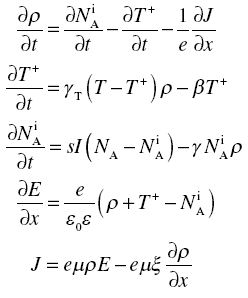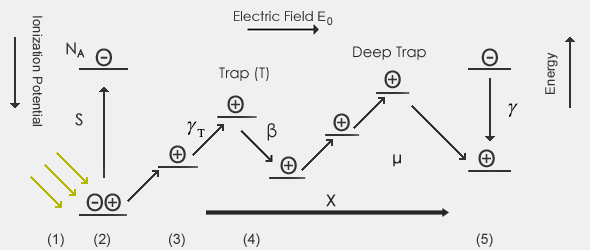Space-Charge Field Formation

The system of nonlinear equations describing dynamics of the
space-charge field formation, in the case of one trap level.
- ρ is the free charge (hole) density
- NA is the total density of acceptors
- NiA is the density of ionized acceptors
- T+ and T are the densities of filled traps and total trapping sites, respectively
- E is the total electric field
- I is the incident light intensity
- J is the current density
- μ is the charge carrier drift mobility
- S is the total cross-section of the photogeneration process
- &epsilon0 is the dielectric permittivity of vacuum
- ε is the dielectric constant of the material
- ξ is the diffusion coefficient

(1) A beam of light with a specific frequency ω (or wavelength λ) is incident on the material. (2) The light is absorbed by an acceptor (NA), and a photoexcited electron is separated from a hole, creating a free hole and an ionized acceptor. (3) The hole moves under electric field E0 along the transport sites with mobility μ. (4) The hole can be trapped with a rate γT at a trapping site (T) and then thermally released (detrapped) with a rate β. More than one kind of a trap can be present in the material. (5) Finally, a hole can recombine with another ionized acceptor with a rate γ.O. Ostroverkhova, "Organic and Polymeric Photorefractive Materials and Devices", in "Introduction to Organic Electronic and Optoelectronic Materials and Devices" (Eds. S. Sun and L. Dalton, CRC Press, 2008) .
For more information regarding modeling of the space-charge field formation in photorefractive materials, see References O. Ostroverkhova and K. D. Singer, J.Appl. Phys. 92, 1727 (2002), L. Kulikovski et al., Phys. Rev. B 69, 125216 (2004), J. Schildkraut and A. Buettner, J. Appl. Phys. 72, 1888 (1992), J. Schildkraut and Y. Cui, J. Appl. Phys. 72, 5055 (1992), C. Lee et al., Chem. Phys. Lett. 422, 106 (2006).

